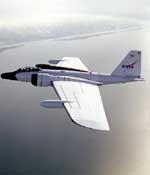
Image credit: NASA/JPL
One aspect of the Earth’s climate, the distribution of water vapour, might have significant implications for climate change and ozone depletion. To understand its significance, NASA scientists are using special aircraft to build a detailed map of how water vapour moves around in the atmosphere, from the surface of the Earth up to an altitude of 40 km, where the air completely dries out. They were able to tell which vapour was created at high altitudes and which was moved up by air currents.
NASA scientists have opened a new window for understanding atmospheric water vapor, its implications for climate change, and ozone depletion.
The scientists have created the first detailed map of water containing heavy hydrogen and heavy oxygen atoms in and out of clouds, from the surface of Earth to some 25 miles upward, to better understand the dynamics of how water gets into the stratosphere.
Only small amounts of water reach the arid stratosphere, 10 to 50 kilometers (6 to 25 miles) above Earth, so any increase in the water content could potentially lead to destruction of some ozone-shielding capability in this part of the atmosphere. This could produce larger ozone depletions over the North and South Poles as well as at mid-latitudes.
Water shapes Earth’s climate. The large amount of it in the lower atmosphere, the troposphere, controls how much sunlight gets through to the planet, how much is trapped in our skies, and how much goes back out to space. Higher in the stratosphere, where most of the Earth’s ozone shield protects the surface from harmful ultraviolet rays, there is very little water (less than .001 of the surface concentration). Scientists don’t fully understand how air is dried before it gets to this region.
In the troposphere, water exists as vapor in air, as liquid droplets in clouds, and as frozen ice particles in high altitude cirrus clouds. Since there is so much water closer to Earth and so few miles above, it is important to understand how water enters and leaves the stratosphere. The “isotopic content,” the natural fingerprint left by the heavy forms of water, is key to understanding the process. An isotope is any of two or more forms of an element having the same or very closely related chemical properties and the same atomic number, but different atomic weights. An example is oxygen 16 versus oxygen 18– both are oxygen, but one is heavier than the other.
Heavy water is more readily condensed or frozen out from its vapor, causing the nature of its distribution to differ somewhat from the usual isotopic form of water. A measurement of the isotopic make-up of water vapor enables scientists to determine how water gets into the stratosphere.
“For the first time, we have water isotope content mapped in incredible detail,” said Dr. Christopher R. Webster, a senior research scientist at NASA’s Jet Propulsion Laboratory, Pasadena, Calif. Webster is principal author of a scientific paper announcing the new findings in the journal Science. Dr. Andrew J. Heymsfield, of the National Center for Atmospheric Research, Boulder, Colo., is co-author.
Measuring water isotopes is extremely challenging, because they represent only a small fraction, less than one percent, of the total water in the atmosphere. Detailed measurements were made using an Aircraft laser infrared absorption spectrometer (Alias) flying aboard NASA’s WB-57F high- altitude jet aircraft in July 2002. This new laser technique enables mapping of water isotopes with sufficient resolution to help researchers understand both water transport and the detailed microphysics of clouds, key parameters for understanding atmospheric composition, storm development and weather prediction.
“The laser technique gives us the ability to measure the different types of isotopes found in all water,” said Webster. “With the isotopic fingerprint, we discovered the ice particles found under the stratosphere were lofted from below, and some were grown there in place.”
The data help explain how the water content of air entering the stratosphere is reduced, and show that gradual ascent and rapid upward motion associated with tall cloud systems (convective lofting) both play roles in establishing the dryness of the stratosphere.
The purpose of the aircraft mission was to understand the formation, extent and processes associated with cirrus clouds. The mission used six aircraft from NASA and other federal agencies to make observations above, in and below the clouds. By combining aircraft data with ground-based data and satellites, scientists have a better picture of the relationship between clouds, water vapor and atmospheric dynamics than previously. They also can better interpret satellite measurements routinely made by NASA.
The mission was funded by NASA’s Earth Science Enterprise. The Enterprise is dedicated to understanding the Earth as an integrated system and applying Earth System Science to improve prediction of climate, weather and natural hazards using the unique vantage point of space. For more information about Alias, visit: http://laserweb.jpl.nasa.gov.
For information about NASA, visit: http://www.nasa.gov.
JPL is managed for NASA by the California Institute of Technology in Pasadena
Original Source: NASA/JPL News Release
